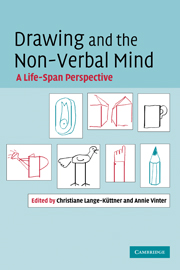Book contents
- Frontmatter
- Contents
- Contributors
- 1 Contemporary enquiries into a long-standing domain: Drawing research
- Part I Self, symbols and intention
- 2 Understanding reflections of self and other objects
- 3 Drawing production, drawing re-experience and drawing re-cognition
- 4 Style and other factors affecting children's recognition of their own drawings
- 5 Children's understanding of the dual nature of pictures
- 6 Pictorial intention, action and interpretation
- Part 2 Syntax, space systems and projection
- Part III Aging, blindness and autism
- Index
- References
6 - Pictorial intention, action and interpretation
Published online by Cambridge University Press: 22 September 2009
- Frontmatter
- Contents
- Contributors
- 1 Contemporary enquiries into a long-standing domain: Drawing research
- Part I Self, symbols and intention
- 2 Understanding reflections of self and other objects
- 3 Drawing production, drawing re-experience and drawing re-cognition
- 4 Style and other factors affecting children's recognition of their own drawings
- 5 Children's understanding of the dual nature of pictures
- 6 Pictorial intention, action and interpretation
- Part 2 Syntax, space systems and projection
- Part III Aging, blindness and autism
- Index
- References
Summary
Freeman and Adi-Japha show that drawing production necessarily involves several steps that are specifically analysed in this chapter. Forming an intention precedes and accompanies the action sequences making up the process of production. The emerging product, the trace left on the graphic surface, stimulates an interpretation that normally should conform to the intention. The authors argue evidence is needed that bears on the child's emerging grasp of intention–action–interpretation links. Some evidence shows that the links in the production system start operating separately by approximately age 3 years, though even earlier indications of drawing-related symbolic actions can be observed in scribblers. In that light, a special case is made for reviving research on human figure drawing. Throughout the chapter, Freeman and Adi-Japha develop an original point of view arguing that researchers should take both a backwards look at drawing rules that children have to suppress and a forwards look at the rules they newly engage with, in order to generate a process model of drawing development. Evidence coming from the literature on the so-called canonical bias in drawing is particularly enlightening in this respect. Note that this perspective shares some features with the one suggested by Jolley, in the sense that Freeman and Adi-Japha give much attention to the changes occurring in executive processes, in particular to inhibition, when they address drawing behaviour.
whenever child development is orderly enough for typical progressions to be identified, researchers often devote much effort to specifying advances that children learn to make.
- Type
- Chapter
- Information
- Drawing and the Non-Verbal MindA Life-Span Perspective, pp. 104 - 120Publisher: Cambridge University PressPrint publication year: 2008
References
- 14
- Cited by



